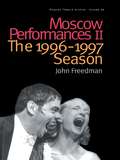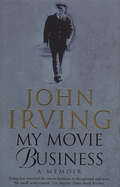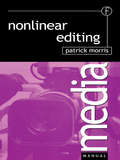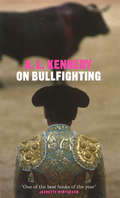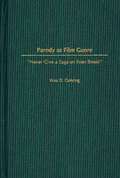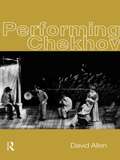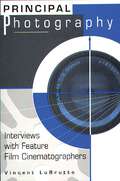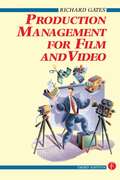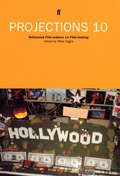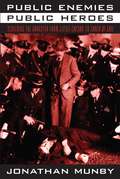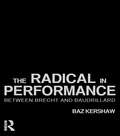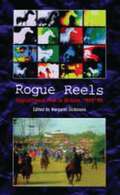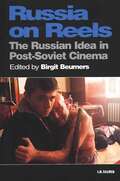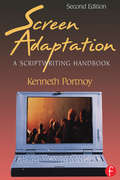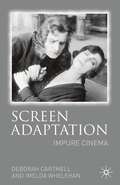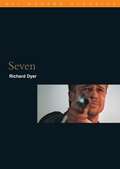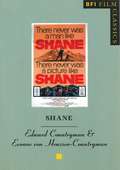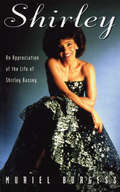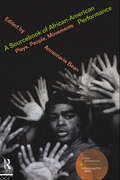- Table View
- List View
Moscow Performances II: The 1996-1997 Season
by John FreedmanThis is a collection of John Freedman's reviews and articles, most originally written for the Moscow Times, in which he focuses his expert critical eye on the directors, writers and actors who held centre stage during the 1996-97 theatre season in Moscow. The book looks at the debut of promising new artists and directors at the Moscow Art Theatre celebrating its 100th anniversary this year and offers a wealth of insight into the latest developments in Russian theatre. Freedman illuminates all of the season's noteworthy trends and events in clear, informed and unapologetically opinionated reports. More than just an overview of the stars and highlights, Moscow Performances II observes at close range the playhouses and the people who make up the ever-changing face of contemporary Russian theatre today. This volume is generously illustrated with photographs of featured productions and will be a useful reference for students, professors, writers, directors and actors in the fields of Russian studies, theatre studies, theatre history and contemporary culture.
Moscow Performances II: The 1996-1997 Season
by John FreedmanThis is a collection of John Freedman's reviews and articles, most originally written for the Moscow Times, in which he focuses his expert critical eye on the directors, writers and actors who held centre stage during the 1996-97 theatre season in Moscow. The book looks at the debut of promising new artists and directors at the Moscow Art Theatre celebrating its 100th anniversary this year and offers a wealth of insight into the latest developments in Russian theatre. Freedman illuminates all of the season's noteworthy trends and events in clear, informed and unapologetically opinionated reports. More than just an overview of the stars and highlights, Moscow Performances II observes at close range the playhouses and the people who make up the ever-changing face of contemporary Russian theatre today. This volume is generously illustrated with photographs of featured productions and will be a useful reference for students, professors, writers, directors and actors in the fields of Russian studies, theatre studies, theatre history and contemporary culture.
My Movie Business: A Memoir
by John IrvingJohn Irving's memoir begins with his account of the distinguished career and medical writings of the novelist's grandfather Dr Frederick C. Irving, a renowned obstetrician and gynaecologist, and includes Mr Irving's incisive history of abortion politics in the United States. But My Movie Business focuses primarily on the thirteen years John Irving spent adapting his novel The Cider House Rules for the screen - for four different directors.Mr Irving also writes about the failed effort to make his first novel, Setting Free the Bears, into a movie, about two of the films that were made from his novels (but not from his screenplays), The World According to Garp and The Hotel New Hampshire; about his slow progress at shepherding his screenplay of A Son of the Circus into production.Not least, and in addition to its qualities as a memoir - anecdotal, comic, affectionate and candid - My Movie Business is an insightful essay on the essential differences between writing a novel and writing a screenplay.
Nonlinear Editing (Media Manuals Ser.)
by Patrick MorrisNonlinear is a buzzword for every broadcaster and facility house worldwide. Systems range from the humble to the exotic, and despite the growing acceptance of the technology, many users, both new and experienced, find the complexity of the operation and the time spent loading the material and rendering effects difficult to manage at first. Non-linear editing also comes with its own specialist language, requiring each editor to be conversant with a new range of skills from day one. As desktop systems improve the role of the traditional editor is constantly evolving and expanding. This is an operational manual for professional trainees and students in the post-production industry. It will also serve as a useful reference tool for producers and directors. Written in a concise and clear manner, the book serves as a practical guide to the efficient management and operation of non-linear editing systems. It describes the technology involved, the essential techniques to be mastered including on-line and off-line editing, project management, rendering effects, working with graphics and audio, and adding third party applications. Designed for quick and easy reference, this is a practical user guide to non-linear editing that comes complete with an extensive jargon buster that will get you fully conversant with the technology in a short space of time.Patrick Morris is a Trainer in Post-Production for the Television Corporation of Singapore and the Singapore Broadcasting Authority as well as Chairman of the South East Asia User Group. He is an AVID Certified Trainer with a working knowledge of Lightworks, Media 100, Quantel, D Vision and other systems. Formerly a consultant and Senior Editor for BBC, ITV and SKY TV, he also spent many years a Training Manager for BBC Wood Norton and as Senior Video-Tape Editor for Television South West.
Nonlinear Editing
by Patrick MorrisNonlinear is a buzzword for every broadcaster and facility house worldwide. Systems range from the humble to the exotic, and despite the growing acceptance of the technology, many users, both new and experienced, find the complexity of the operation and the time spent loading the material and rendering effects difficult to manage at first. Non-linear editing also comes with its own specialist language, requiring each editor to be conversant with a new range of skills from day one. As desktop systems improve the role of the traditional editor is constantly evolving and expanding. This is an operational manual for professional trainees and students in the post-production industry. It will also serve as a useful reference tool for producers and directors. Written in a concise and clear manner, the book serves as a practical guide to the efficient management and operation of non-linear editing systems. It describes the technology involved, the essential techniques to be mastered including on-line and off-line editing, project management, rendering effects, working with graphics and audio, and adding third party applications. Designed for quick and easy reference, this is a practical user guide to non-linear editing that comes complete with an extensive jargon buster that will get you fully conversant with the technology in a short space of time.Patrick Morris is a Trainer in Post-Production for the Television Corporation of Singapore and the Singapore Broadcasting Authority as well as Chairman of the South East Asia User Group. He is an AVID Certified Trainer with a working knowledge of Lightworks, Media 100, Quantel, D Vision and other systems. Formerly a consultant and Senior Editor for BBC, ITV and SKY TV, he also spent many years a Training Manager for BBC Wood Norton and as Senior Video-Tape Editor for Television South West.
On Bullfighting (Yellow Jersey Shorts Ser.)
by A. L. KennedyBullfighting - the ultimate spectator sport.Acclaimed novelist A. L. Kennedy unpeels the layers and explains the mechanics before dissecting them with surgical precision. Beyond the theatre, the costume and the well-worn plot she focuses on the fact that a man faces his death while a crowd looks on. The result is a startling confrontation with her own, and mankind's, mortality.
Parody as Film Genre: Never Give a Saga an Even Break (Contributions to the Study of Popular Culture)
by Wes D. GehringParody is the least appreciated of all film comedy genres and receives little serious attention, even among film fans. This study elevates parody to mainstream significance. A historical overview places the genre in context, and a number of basic parody components, which better define the genre and celebrate its value, are examined. Parody is differentiated from satire, and the two parody types, traditional and reaffirmation, are explained. Chapters study the most spoofed genre in American parody history, the Western; pantheon members of American Film Comedy such as The Marx Brothers, W. C. Fields, Mae West, and Laurel and Hardy; pivotal parody artists, Bob Hope and Woody Allen; Mel Brooks, whose name is often synonymous with parody; and finally, parody in the 1990s. Films discussed include Destry Rides Again (1939), The Road to Utopia (1945), My Favorite Brunette (1947), The Paleface (1948), Butch Cassidy and the Sundance Kid (1969), Blazing Saddles (1974), Young Frankenstein (1974), Hot Shots! Part Deux (1993) and Scream (1996).This examination of parody will appeal to scholars and students of American film and film comedy, as well as those interested in the specific comedians discussed and the Western genre. Gehring's work will also find a place in American pop culture studies and sociological studies of the period from the 1920s to the 1990s. The book is carefully documented and includes a selected bibliography and filmography.
Performing Chekhov
by David AllenFirst published in 1999. Routledge is an imprint of Taylor & Francis, an informa company.
Performing Chekhov
by David AllenFirst published in 1999. Routledge is an imprint of Taylor & Francis, an informa company.
Principal Photography: Interviews with Feature Film Cinematographers
by Vincent LoBruttoBy using photography as a storytelling medium, the cinematographer plays a key role in translating a screenplay into images and capturing the director's vision of a film. This volume presents in-depth interviews with 13 prominent cinematographers, who discuss their careers and the art and craft of feature film cinematography. The interviewees—who represent the spectrum of big-budget Hollywood and low-budget independent filmmaking from the sixties through the nineties—talk about their responsibilities, including lighting, camera movement, equipment, cinematic grammar, lenses, film stocks, interpreting the script, the budget and schedule, and the psychological effect of images. Each interview is preceded by a short biography and a selected filmography, which provide the background for a detailed analysis of the photographic style and technique of many highly acclaimed and seminal films.
Production Management for Film and Video
by Richard GatesPacked with step by step information, hints and tips, this book provides all the basic information needed to production manage a film or video from beginning to end - from idea to delivery. Production Management for Film and Video gives all the basic information needed to production manage a film or video from beginning to end - from idea to delivery.Aspiring young film producers, programme makers and students of film or video production will find this an essential source of information, as indeed will anybody wishing to improve their knowledge and skills in the field. One is guided from the script or proposal, right through the various stages of production management to include:· script breakdown· crossplotting· scheduling· budgeting· preparation· the shoot· editing and post-production· deliveryNow in its third edition, Production Management for Film and Video has been further revised to include: · information on health and safety requirements· the need to be aware of computer generated imagery · the effect this kind of programme making has on schedules and budgets. Different kinds of management for different productions are also covered - from features through to documentaries - and advice is offered on how to run a production more effectively. Examples, taken from actual productions, demonstrate the kind of documentation needed to develop, run and control a production. Emphasis is placed on the basic principles of good management that apply to all the different kinds of film that can be produced.Richard Gates is a freelance producer/production manager and has been involved in over 40 productions of different kinds. He also lectures extensively on production and production management techniques.
Production Management for Film and Video
by Richard GatesPacked with step by step information, hints and tips, this book provides all the basic information needed to production manage a film or video from beginning to end - from idea to delivery. Production Management for Film and Video gives all the basic information needed to production manage a film or video from beginning to end - from idea to delivery.Aspiring young film producers, programme makers and students of film or video production will find this an essential source of information, as indeed will anybody wishing to improve their knowledge and skills in the field. One is guided from the script or proposal, right through the various stages of production management to include:· script breakdown· crossplotting· scheduling· budgeting· preparation· the shoot· editing and post-production· deliveryNow in its third edition, Production Management for Film and Video has been further revised to include: · information on health and safety requirements· the need to be aware of computer generated imagery · the effect this kind of programme making has on schedules and budgets. Different kinds of management for different productions are also covered - from features through to documentaries - and advice is offered on how to run a production more effectively. Examples, taken from actual productions, demonstrate the kind of documentation needed to develop, run and control a production. Emphasis is placed on the basic principles of good management that apply to all the different kinds of film that can be produced.Richard Gates is a freelance producer/production manager and has been involved in over 40 productions of different kinds. He also lectures extensively on production and production management techniques.
Projections 10: Hollywood Film-makers On Film-making
by Mike FiggisMike Figgis has always been intrigued by the workings of the Hollywood System. As he progressed from his acclaimed US debut Internal Affairs, through hellish studio wrangles on Mr. Jones, to Oscar-laurelled success with Leaving Las Vegas, Figgis always wanted to find a way to document the mores of the Hollywood industry, before it could swallow him whole. For Projections, he accepted an invitation to return to LA in late 1998 and create just such a document. In conversation with established players such as Mel Gibson, Jodie Foster and Jerry Bruckheimer, plus ascending talents such as Salma Hayek and Paul Thomas Anderson, Figgis paints a refreshingly honest but unmistakably dark portrait of an industry where money does more than talk.Mike Figgis's witnesses include Mel Gibson, Jodie Foster, Mickey Rourke, Nastassja Kinski, Elizabeth Shue, Salma Hayek, Paul Thomas Anderson, Jerry Bruckheimer and many more . . .
Public Enemies, Public Heroes: Screening the Gangster from Little Caesar to Touch of Evil
by Jonathan MunbyIn this study of Hollywood gangster films, Jonathan Munby examines their controversial content and how it was subjected to continual moral and political censure. Beginning in the early 1930s, these films told compelling stories about ethnic urban lower-class desires to "make it" in an America dominated by Anglo-Saxon Protestant ideals and devastated by the Great Depression. By the late 1940s, however, their focus shifted to the problems of a culture maladjusting to a new peacetime sociopolitical order governed by corporate capitalism. The gangster no longer challenged the establishment; the issue was not "making it," but simply "making do." Combining film analysis with archival material from the Production Code Administration (Hollywood's self-censoring authority), Munby shows how the industry circumvented censure, and how its altered gangsters (influenced by European filmmakers) fueled the infamous inquisitions of Hollywood in the postwar '40s and '50s by the House Committee on Un-American Activities. Ultimately, this provocative study suggests that we rethink our ideas about crime and violence in depictions of Americans fighting against the status quo.
The Radical in Performance: Between Brecht and Baudrillard
by Baz KershawThe Radical in Performance investigates the crisis in contemporary theatre, and celebrates the subversive in performance. It is the first full-length study to explore the link between a western theatre which, says Kershaw, is largely outdated and the blossoming of postmodern performance, much of which has a genuinely radical edge. In staying focused on the period between Brecht and Baudrillard, modernity and postmodernism, Baz Kershaw identifies crucial resources for the revitalisation of the radical across a wide spectrum of cultural practices. This is a timely, necessary and rigorous book. It will be a compelling read for anyone searching for a critical catalyst for new ways of viewing and practising cultural politics.
The Radical in Performance: Between Brecht and Baudrillard
by Baz KershawThe Radical in Performance investigates the crisis in contemporary theatre, and celebrates the subversive in performance. It is the first full-length study to explore the link between a western theatre which, says Kershaw, is largely outdated and the blossoming of postmodern performance, much of which has a genuinely radical edge. In staying focused on the period between Brecht and Baudrillard, modernity and postmodernism, Baz Kershaw identifies crucial resources for the revitalisation of the radical across a wide spectrum of cultural practices. This is a timely, necessary and rigorous book. It will be a compelling read for anyone searching for a critical catalyst for new ways of viewing and practising cultural politics.
Rogue Reels: Oppositional Film in Britain, 1945-90
by Margaret DickinsonMargaret Dickinson's history of oppostional film is a pioneering account of an important by little documented aspect of modern British Cinema: the often extreme form of independent cinema that accompanied the radical politics of the 1960s and 70s. During the 70s an organized independent film and video movement emerged (including such filmmaking groups as London Filmmakers' Co-op, Cinema Action, Amber, Liberation Films and Sheffield Co-op). This avant-garde exerted an increasing influence within the British media mainstream - changing attitudes and practice, and enabling cross-over work by filmmakers such as Peter Greenaway and Sally Potter. This oppostional sector revolutionized British media, especially during the formation of Channel Four at the start of the 1980s, even as the political landscape at large was shifting dramatically to the right. Organized into three parts, 'Rogue Reels 'provides the first overview of the various strands of politicized filmmaking that emerged in postwar Britain. Part I is a concise history of the movement. Part II collects key texts and documents form the period 1971-92. Part III is made up of seven oral histories of the most influential production houses. Recuperating the radical tradition of postwar filmmaking (which continues to impact on today's media culture), 'Rogue Reels' raises urgent issues of policy and practice. Mixing narrative with first-hand accounts, and the important statements and documents of this movement the book provides the first overview of the different strands of filmmaking that are still impacting on avant-garde and mainstream practice.
Russia on Reels: The Russian Idea in Post-Soviet Cinema (KINO - The Russian and Soviet Cinema)
by Birgit BeumersThis is the first book to deal exclusively with Russian cinema of the 1990s. It introduces readers to the currents and common interests of contemporary Russian cinema, offers close studies of the work of filmmakers like Sokurov, Muratova and Astrakhan, reviews the Russian film industry in a period of massive economic transformation, and assesses cinema's function as a definer of Russia's new identity.
Screen Adaptation: A Scriptwriting Handbook
by Kenneth PortnoyScreen Adaptation : A Scriptwriting Handbook, 2nd ed. examines the challenge screenwriters face when adapting novels, plays, and short stories for the screen. Thoroughly updated to include new exercises and example from current films, this book provides practical, usable information on how to find the best plot line for a script, choose key characters, and understand the goals and formats of different genres. Topics include: determining which characters and events are most valuable on developing the main story;expanding short novellas and condensing long novels;using dialog to advance the story and reveal character;comparing the formats of plays, short stories, and novels to those of screenplaysapproaching the marketplaceIn this book, both beginning writers and professionals will find the tools necessary to evaluate a prospective source and create a successful screenplay
Screen Adaptation: A Scriptwriting Handbook
by Kenneth PortnoyScreen Adaptation : A Scriptwriting Handbook, 2nd ed. examines the challenge screenwriters face when adapting novels, plays, and short stories for the screen. Thoroughly updated to include new exercises and example from current films, this book provides practical, usable information on how to find the best plot line for a script, choose key characters, and understand the goals and formats of different genres. Topics include: determining which characters and events are most valuable on developing the main story;expanding short novellas and condensing long novels;using dialog to advance the story and reveal character;comparing the formats of plays, short stories, and novels to those of screenplaysapproaching the marketplaceIn this book, both beginning writers and professionals will find the tools necessary to evaluate a prospective source and create a successful screenplay
Screen Adaptation: Impure Cinema
by Hester Bradley Imelda WhelehanAdaptation studies has historically been neglected in both the English and Film Studies curricula. Reflecting on this, Screen Adaptation celebrates its emergence in the late 20th and 21st centuries and explores the varieties of methodologies and debates within the field. Drawing on approaches from genre studies to transtexuality to cultural materialism, the book examines adaptations of both popular and canonical writers, including William Shakespeare, Jane Austen and J.K.Rowling.Original and provocative, this book will spark new thinking and research in the field of adaptation studies. Mapping the way in which this exciting field has emerged and shifted over the last two decades, the book is also essential reading for students of English Literature and Film.
Seven: Smew's Greed (BFI Film Classics)
by Richard DyerGluttony, Greed, Sloth, Lust, Pride, Envy, Wrath. A serial killer on a warped mission who turns his victims' 'sins' into the means of their murder. Seven (David Fincher, 1995) is one of the most acclaimed American films of the 1990s. Starring Morgan Freeman, Brad Pitt, and Kevin Spacey, Seven is the darkest of films. In it performance, cinematography, sound, and plot combine to create a harrowing account of a world beset by an all-encompassing, irremediable wickedness. Richard Dyer explores the film in terms of of sin, story, structure, seriality, sound, sight and salvation, analyzing how Seven both epitomizes and modifies the serial killer genre, which is such a feature of recent cinema.
Shane (BFI Film Classics)
by Edward Countryman Evonne Von Heussen-CountrymanThis text looks at the film 'Shane' (1983) directed by George Stevens, then one of Hollywood's most successful film-makers. Alan Ladd plays the charismatic outsider who defends a community against a predatory gang and, in so doing, transforms the life of a family.
Shirley: An Appreciation Of The Life Of Shirley Bassey
by Muriel BurgessShirley Bassey is one of the all-time greats of the entertainment business. She has sold more records than any other British female singer and still commands massive audiences around the world. Now, after a career spanning decades, her life story can be told: the story of a triumph over enough tragedies to last several lifetimes. The personal hardships that have fuelled the emotionalism of her songs have never before been revealed. Here her poverty-stricken childhood in Wales is detailed: how her mother struggled to bring up seven children on Income Support after their Nigerian father was deported; how she worked in a saucepan factory when her first struggles for stardom were halted by her pregnancy at sixteen. Shirley had a series of tortured loves: she married a homosexual Cockney who died of an overdose; she had a highly publicised affair with actor Peter Finch; and her second marriage, to an Italian, also failed. The shocking death of her second daughter, Samantha, just before her 21st birthday caused Shirley to lose her voice for nearly a year. Behind the showbiz glamour and consummate professionalism lies a fiercely resilient and independent woman.
A Sourcebook on African-American Performance: Plays, People, Movements (Worlds of Performance)
by Annemarie BeanA Sourcebook on African-American Performance is the first volume to consider African-American performance between and beyond the Black Arts Movement of the 1960s and the New Black Renaissance of the 1990s.As with all titles in the Worlds of Performance series, the Sourcebook consists of classic texts as well as newly commissioned pieces by notable scholars, writers and performers. It includes the plays 'Sally's Rape' by Robbie McCauley and 'The American Play' by Suzan-Lori Parks, and comes complete with a substantial, historical introduction by Annemarie Bean.Articles, essays, manifestos and interviews included cover topics such as:* theatre on the professional, revolutionary and college stages* concert dance* community activism * step shows* performance art.Contributors include Annemarie Bean, Ed Bullins, Barbara Lewis, John O'Neal, Glenda Dickersun, James V. Hatch, Warren Budine Jr. and Eugene Nesmith.
